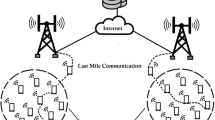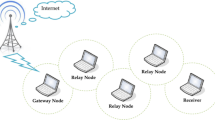Abstract
The current paper presents a collection of experimental data portraying the performance achieved in the wireless setting by several TCP-friendly congestion controls recently proposed in literature. This work is partly motivated by the consideration that the majority of the analytical results in this area are validated by simulation, rather than by field tests. Examining these algorithms in real environments can help verify their actual effectiveness over the wireless Internet. To reach such goal, two representative controls among the so-called window-based TCP-friendly schemes have been implemented, namely, the General Additive Increase Multiplicative Decrease (GAIMD) strategy, and the SQuare RooT (SQRT) binomial control; the most representative algorithm among rate-based controls, the TCP Friendly Rate Control (TFRC), has also been considered. Their TCP-fairness and smoothness have been comprehensively evaluated in an IEEE 802.11g Wireless Local Area Network (WLAN). The obtained results show that the GAIMD and SQRT strategies reveal non-negligible scalability and smoothness problems, that markedly limit their performance. It is empirically demonstrated that their “optimal” increase/decrease rules, based on TCP-Reno analytical model, cannot guarantee an adequate performance when GAIMD and SQRT compete with TCP-Sack, a de facto standard for current TCP implementations. TFRC is demonstrated to occasionally behave bewildering: properly tuning one of its congestion control parameters and enhancing the algorithm with a flow-control mechanism result in a definitely fairer share of bandwidth with concurrent TCP flows.
Similar content being viewed by others
References
S. Floyd and K. Fall, Promoting the use of end-to-end congestion control in the internet, IEEE/ACM Transactions on Networking 7(4) (1999) 458–472.
R. Rejaie, M. Handley and D. Estrin, RAP: an end-to-end rate-based congestion control mechanism for realtime streams in the internet, in: Proceedings of the IEEE INFOCOM ’99, Vol. 3 (June 1999) pp. 1337–1345.
Y.R. Yang and S. Lam, General AIMD congestion control, in: Proceedings of IEEE 2000 International Conference on Network Protocols (November 2000) pp. 187–198.
D. Bansal and H. Balakrishnan, Binomial congestion control algorithms, in: Proceedings of IEEE INFOCOM 2001 Vol. 6 (April 2001) pp. 631–640.
S. Jin, L. Guo, I. Matta and A. Bestavros, A spectrum of TCP-friendly window-based congestion control algorithms, IEEE/ACM Transactions on Networking 11(3) (2003) 341–355.
N. Sastry and S. Lam, A theory of window-based unicast congestion control, Network Protocols 2002, in: Proceedings of IEEE International Conference on Network Protocols (November 2002) pp. 144–154.
S. Floyd, M. Handley, J. Padhye and J. Wiedmer, Equation based congestion control for unicast applications, in: Proceedings of ACM/SIGCOMM 2000 Vol. 1 (May 2000) pp. 1–14.
J. Widmer, R. Denda and M. Mauve, A survey on TCP-friendly congestion control, IEEE Network (May/June 2001) pp. 28–39.
D.M. Chiu and R. Jain, Analysis of the increase and decrease algorithms for congestion avoidance in computer networks, Journal of Computer Networks and ISDN 17(1) (1989) 1–14.
D. Bertsekas and R. Gallager, Data Networks (Prentice-Hall, 1987).
Y.R. Yang and S. Lam, Transient behaviors of TCP-friendly congestion control protocols, in: Proceedings of IEEE INFOCOM 2001 (April 2001) pp. 1716–1725.
I. Rhee, V. Ozdemir and Y. Yi, TEAR: TCP emulation at receivers. flow control for multimedia streaming, CS Dept. Technical Report, NCSU (April 2000).
ns2 Network Simulator. Available: http://www.isi.edu/nsnam/ns
Y. Yang and S. Lam, Analysis of binomial congestion control, Technical Report TR-2000-14, Networking Research Laboratory.
M. Borri and M.L. Merani, Performance and TCP-friendliness of the SQRT congestion control protocol in lossy environments, IEEE Communications Letters 8(8) (August 2004).
S. Seshan and H. Balakrishnan, The congestion manager, RFC 3124, 2001, ftp://ftp.rfc-editor.org/in-notes/rfc3124.txt
D. Loguinov and H. Radha, End-to-end rate-based congestion control: Convergence properties and scalability analysis, IEEE/ACM Trans. on Networking 11(4) (2003) 564–577.
M. Handley, S. Floyd, J. Padhye and J. Widmer, TCP friendly rate control (TFRC): Protocol specification, RFC 3448 (January 2003) ftp://ftp.rfc-editor.org/in-notes/rfc3448.txt, proposed standard.
J. Padhye, V. Firoiu, D. Towsley and J. Kurose, Modeling TCP Reno performance: a simple model and its empirical validation, (IEEE/ACM Trans. on Networking) 8(2) (2000) pp. 133–145.
T. Dunigan et al., Almost tcp over udp (ATOU). Description available: http://www.csm.ornl.gov/dunigan/net100/atou.html (2003).
M. Mathi, J. Mahdavi, S. Floyd and A. Romanow, TCP selective acknowledgement options, RFC 2018 (October 1996) ftp://ftp.rfc-editor.org/in-notes/rfc2018.txt
S. Floyd, J. Mahdavi, M. Mathis and M. Podolsky, An extension to the selective acknowledgement (SACK) option for TCP, RFC 2883 (July 2000) ftp://ftp.rfc-editor.org/in-notes/rfc2883.txt, proposed standard.
TFRC experimental code. Available: http://www.icir.org/tfrc/code.
Author information
Authors and Affiliations
Corresponding author
Additional information
Michele Borri received the M.Sc. degree in Computer Engineering from the University of Modena and Reggio Emilia in the academic year 2001–2002 and took a specialisation in Telecommunication Engineering in 2002. His professional activity is currently balanced between researching at the University of Modena and Reggio Emilia, and consulting as a system engineer and network architect. His research interests focus on congestion control and multimedia services in next generation Internet. Michele Borri has been participating to national research projects promoted by the Italian National Research Council (CNR).
Maurizio Casoni is Associate Professor in Telecommunications at the University of Modena and Reggio Emilia. He graduated with honors in Electrical Engineering at the University of Bologna in 1991, with a grant by Telecom Italia and received the Ph.D. degree also in Electrical Engineering from the University of Bologna, in 1995.
In 1995 he was with the Computer Science Department at Washington University in St. Louis, MO, as a research fellow where he worked on ATM broadband switching architectures. He has studied ATM broadband switching architectures and Clos architectures for the design of large photonic switches in the framework of the European Projects ATMOS and KEOPS. He has also investigated the performance of 3rd generation UMTS systems. His current research interests deal with Optical Networking, mainly focusing on Optical Burst Switching, and Satellite Networks. He currently holds the course of Interconnection Systems for undergraduate students and the course of Switching Systems for graduate students of Telecommunications Engineering.
Maria Luisa Merani is currently an associate professor of Telecommunication Networks at the University of Modena and Reggio Emilia, Department of Information Engineering. She is an IEEE Senior member and has served on the Technical Program Committees of several major communication conferences (IEEE ICC, IEEE Globecom, IEEE VTC, APCC). In 2005 she has been technical program cochair of the second IEEE International Symposium in Wireless Communication Systems. In 2007 she will be the Wireless Symposium chair of IEEE Globecom.
At present she is involved in research on congestion control for next generation Internet and on multicast video streaming. Her most recent research interests are related to the area of radio communications, with emphasis on performance evaluation of mobile radio systems, 3G data networking and transport solutions for optical networks.
Maria Luisa Merani received both her M.Sc. (summa cum laude) and Ph.D. in electrical engineering from the University of Bologna, Italy, in the academic years 1985/86 and 1991/92, respectively. In 1992 she spent one year at the Computer Science Department of the University of California in Los Angeles, CA, USA.
Rights and permissions
About this article
Cite this article
Borri, M., Casoni, M. & Merani, M.L. Effectiveness and issues of congestion control in 802.11g wireless LANs. Wireless Netw 14, 171–182 (2008). https://doi.org/10.1007/s11276-006-8917-8
Published:
Issue Date:
DOI: https://doi.org/10.1007/s11276-006-8917-8




